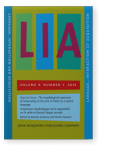The morphological expression of temporality on the verb in French as a second language
References (32)
Bardovi-Harlig, K
(
1999)
From morphemes to temporal semantics: Tense-aspect research in SLA.
Studies in Second Language Acquisition 21(3), 341–382.


Bardovi-Harlig, K
(
2000)
Tense and aspect in second language acquisition. Form, meaning and use (
Language Learning Monograph Series). Oxford: Blackwell.

Bartning, I
(
1997)
L’apprenant dit avancé et son acquisition d’une langue étrangère. Tour d’horizon et esquisse d’une caractérisation de la variété avancée.
AILE 91, 9–50.


Bartning, I
(
2005)
‘Je ne pense pas que ce soit vrai’. Le subjonctif un trait tardif dans l’acquisition du français. In
M. Metzeltin (ed.),
Hommage à Jane Nystedt (31–49). Wien: Drei Eidechsen.

Bartning, I. & Schlyter, S
(
2004)
Itinéraires acquisitionnels et stades de développement en français L2.
Journal of French Language Studies 141, 281–299.


Benazzo, S., Flecken, M. & Soroli, E
Collins, L
(
2002)
The roles of L1 influence and lexical aspect in the acquisition of temporal morphology.
Language Learning 51(2), 43–94.


Dietrich, R., Klein, W. & Noyau, C
Hendriks, H
(
1999)
The acquisition of temporal reference in first and second language acquisition: What children already know and adults still have to learn and vice versa.
Psychology of Language and Communication 3(1), 41–60.

Hickmann, M. & Hendriks, H
in press).
Time talk in narrative discourse: Evidence from child and adult language acquisition. In
J. Guéron (eds.)
Tense, aspect and modality: From sentence grammar to discourse grammar Oxford Oxford University Press

Howard, M
(
2002)
Les interrelations entre les facteurs contextuels contraignant l’emploi variable des temps du passé. Une étude d’apprenants avancés du français.
Revue française de linguistique appliqué VII(2), 31–42.


Howard, M
(
2005)
The emergence and use of the ‘plus-que-parfait’ in advanced French interlanguage. In
J.-M. Dewaele (ed.),
Focus on French as a foreign language. Multidisciplinary perspectives (63–87). Clevedon / Toronto: Multilingual Matters.


Howard, M
(
2008)
Morpho-syntactic development in the expression of modality: The subjunctive in French L2 acquisition.
Canadian Journal of Applied Linguistics 11(3), 171–192.

Howard, M
(
2009)
Expressing irrealis in L2 French: A preliminary study of the conditional and tense-concordancing in L2 acquisition.
Issues in Applied Linguistics 17(2), 113–135.

Howard, M
(
2012)
The advanced learner’s sociolinguistic profile: On issues of individual differences, L2 exposure conditions and type of sociolinguistic variable.
Modern Language Journal 96(1), 20–33.


Labeau, E
(
2005)
Beyond the aspect hypothesis: Tense-aspect development in advanced L2 French. Bern: Peter Lang.

Lambert, M., Carroll, M. & von Stutterheim, C
(
2008)
Acquisition en L2 des principes d’organisation de récits spécifiques aux langues.
AILE 261, 11–29.

Leclercq, P
(
2008)
L’influence de la langue maternelle chez les apprenants adultes quasi-bilingues dans une tâche contrainte de verbalisation. Etude de l’expression du déroulement en français et en anglais.
AILE 261, 51–69.


Leclercq, P
(
2009).
The influence of L1 French on near-native French learners of English: The case of simultaneity. In
E. Labeau &
F. Myles (eds.),
The advanced learner variety: The case of French (269–289). Bern: Peter Lang.

Marsden, E., Mitchell, R., Myles, F. & Rule, S
(
2002)
Oral French interlanguage corpora: tools for data management and analysis. Centre for language in education.
Occasional Papers 581. University of Southampton.

Montrul, S. & Slabakova, R
(
2003)
Competence similarities between native and near-native speakers. An investigation of the preterite/imperfect contrast in Spanish.
Studies in Second Language Acquisition 25(3), 351–398.


Nadasdi, T., Mougeon, R. & Rehner, K
(
2003)
Emploi du futur dans le français parlé d’élèves d’immersion française.
Journal of French Language Studies 13(2), 195–219.


Noyau, C
(
1991)
La temporalité dans le discours narratif : construction du récit, construction de la langue. Thèse d’Habilitation, Université de Paris 8.

Rohde, A
(
1996)
The aspect hypothesis and the emergence of tense distinctions in naturalistic L2 acquisition.
Linguistics 341, 1115–1137.


Salaberry, R
(
1998)
The development of aspectual distinctions in academic L2 French.
Canadian Modern Language Review 54(4), 508–542.


Schlyter, S
(
1998)
La saisie de l’imparfait chez les enfants monolingues, les apprenants adultes et les enfants bilingues.
LINX 381, 145–169.


Cited by (1)
Cited by 1 other publications
Howard, Martin
2021.
Introductory Article: French in Second Language Acquisition Research.
Languages 6:2
► pp. 101 ff.

This list is based on CrossRef data as of 5 july 2024. Please note that it may not be complete. Sources presented here have been supplied by the respective publishers.
Any errors therein should be reported to them.
